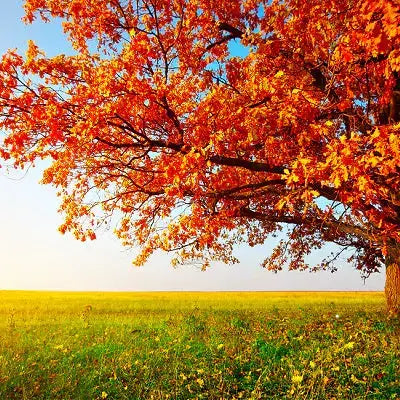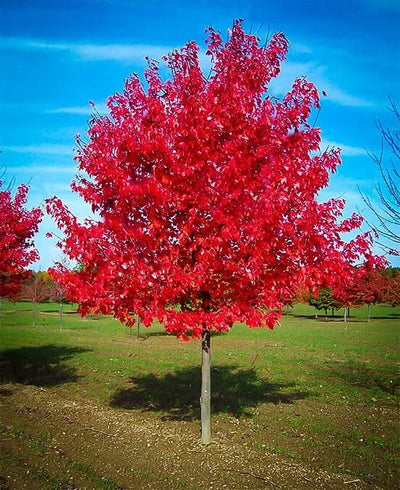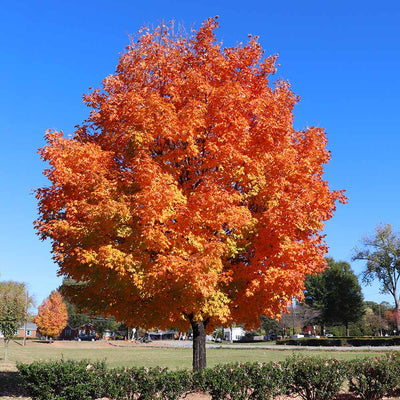Why the change in color?
Why do you think trees lose their green color during autumn? Every single year trees go through what some may call a magical process, where their color changes from green to bright red, orange, and even yellow. It is part of the trees natural cycle. Understanding the process of the changes in color adds to your appreciation of nature and the changing seasons.Photosynthesis is the beginning
The first phase is and remains the illusion shattering photosynthesis. It is the act in which vegetal forms of life capture the light emanating from the star at the center of our solar system and combine it with water and the gassy byproduct of combustion, carbon dioxide, to eject molecular oxygen and a carbohydrate: glucose. Such shades of green are the color of spring time foliage for the reason they contain the dye chlorophyll which enables trees to capture the aforementioned light. Schrodinger's light, if you like, which keeps empires of trees alive.
The Role of Temperature and Daylight in Painting the Landscape Monochrome
The amount of daylight and temperature are very important in determining which trees develop color and in what intensity. In regions where the temperature in fall drops significantly in the evening, the chlorophyll breakdown continues and the crest of the trees becomes artistically adorned in glorious red and purple colors from the produced anthocyanins.
The color change process, particularly chlorophyll breakdown and anthocyanin synthesis, occurs significantly faster than in the southern regions. Trees here drop leaves before the frost settles, a process that’s referred to as leaf stripping. In the Southern regions, the gentler weather lengthens the beautiful fall coloring and thus the trees here drop their leaves much later than in the North.
Which Trees Show the Most Color?
Some trees remain unchanged during seasons, which includes the very conspicuous broad leaf trees. Evergreens such as spruces and pines keeps their leaves despite the temperature drops. Such foliage does not go unnoticed in the South as the warmer regions are primarily populated with evergreens.
On the other hand, Northern areas might see oak trees with dead foliage still clinging to their leaves until Winter ends, then the leaves start to grow back again in Spring. The timing, along with the intensity, for the change in color of leaves also shifts depending on the specific climate for the region.
Changes Depending on a Region with Fall Foliage
In the thirteen Northern states within the USA, leaf peeping in these areas often begins in September as the foliage in these areas changes to its autumn colors. The combination of frost along with cold weather often controls the timing of leaf drop, which is why individuals traveling to the North are advised to appreciate the autumn foliage while they still can. In the South, with the better weather, trees can hold onto their full foliage longer, thus the center of fall color changes happens later, shifting to the time of late October and early November. Because of this, southern states have a longer time period to appreciate the beautiful leaves.
Famous Shrubs/Plants/Tree That Show Off in Fall
Autumn Blaze Maple: The tree is well known for its fall color adds a striking red and orange shades to a fall foliage and thus adds to the stunning visula during that time.
Burning Bush: It’s a common shrub used in gardens and during fall, this adds a brilliant red color to the whole garden, thus a common favorite.
Sugar Maple: Regarded as the main symbol for fall in North America for many, the leaves and trees are known for their golden yellow shades.
Why Do Leaves Change Color During Fall
Abscission for trees is when the trees begin to cover the cells at the base of the leaf stem and stops the flow of water and nutrients. The water and nutrients makes the leaves dry off and it makes the tree shed leaves. The tree is saving water and energy for the winter when it has scarce water.
Conclusion: Enjoy the Fall Foliage
Once you learn about the process of leaf color change the seasons of the year become a lot more interesting. The North and South both get to experience the beautiful sight of the leaves changing every year. The North gets to see the leaves first, while the South gets to enjoy them for a longer period.
Enjoy the fall color with the beautiful fall trees and shrubs. Use TN Nursery to find the plants that will add color to your garden.
FAQs
Why do leaves change in the fall?
Subsequently, as the temperature droops, the amount of sunlight stricken the leaves, the leaves begin to undergo photosynthesis slower than normal, which causes the break down of chlorophyll faster than normal.
What are the three factors that cause leaves to change color?
As noted before, leaves change color as a result of a lack of sunlight, colder weather, and the lack of chlorophyll being produced.
What causes leaves to fall during the fall?
Abscission, which occurs in the tree’s other branches as a way to keep warm during the winter, occurs when the dry leaf is plucked off of the tree, thus conserving both water and energy.
Why do trees need leaves?
Leaves help trees get “food” from the light of the sun and water and the air through a process called photosynthesis. This “food” enables trees to grow and store energy for winter. Winter is a critical time as trees do not “eat” during this time.
What is the science behind the color of autumn?
The science of autumn leaves is the breakdown of chlorophyll. When less sunlight is available, chlorophyll diminishes causing carotenoids and anthocyanins to chlorophyll, thus bringing the leaves to red, orange and yellow and other beautiful fall colors.




